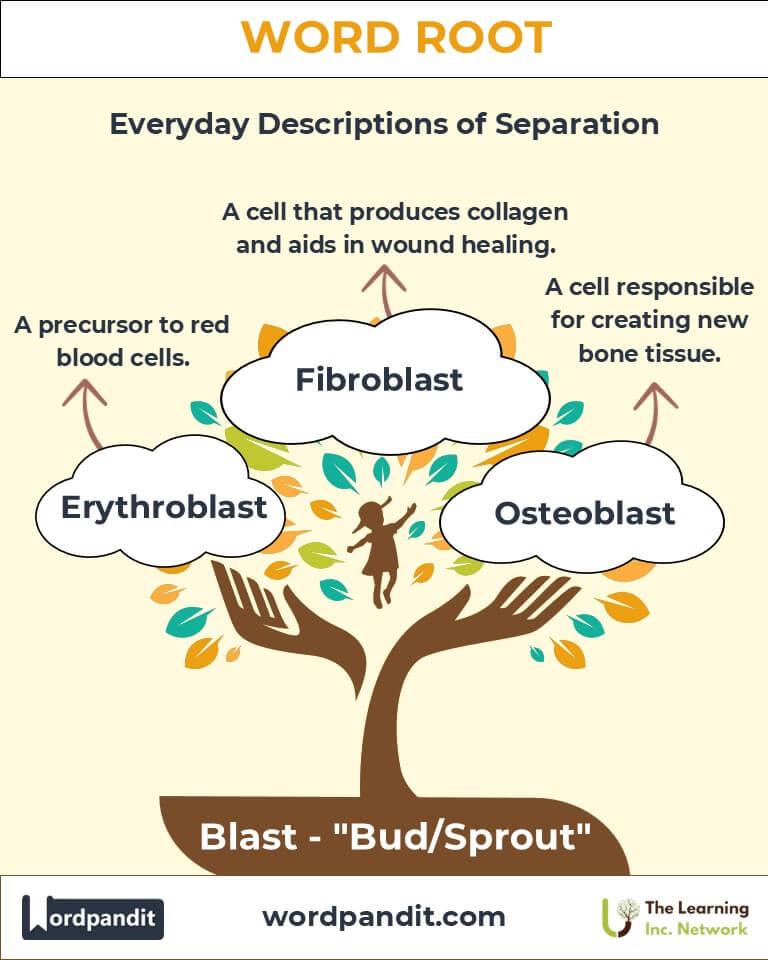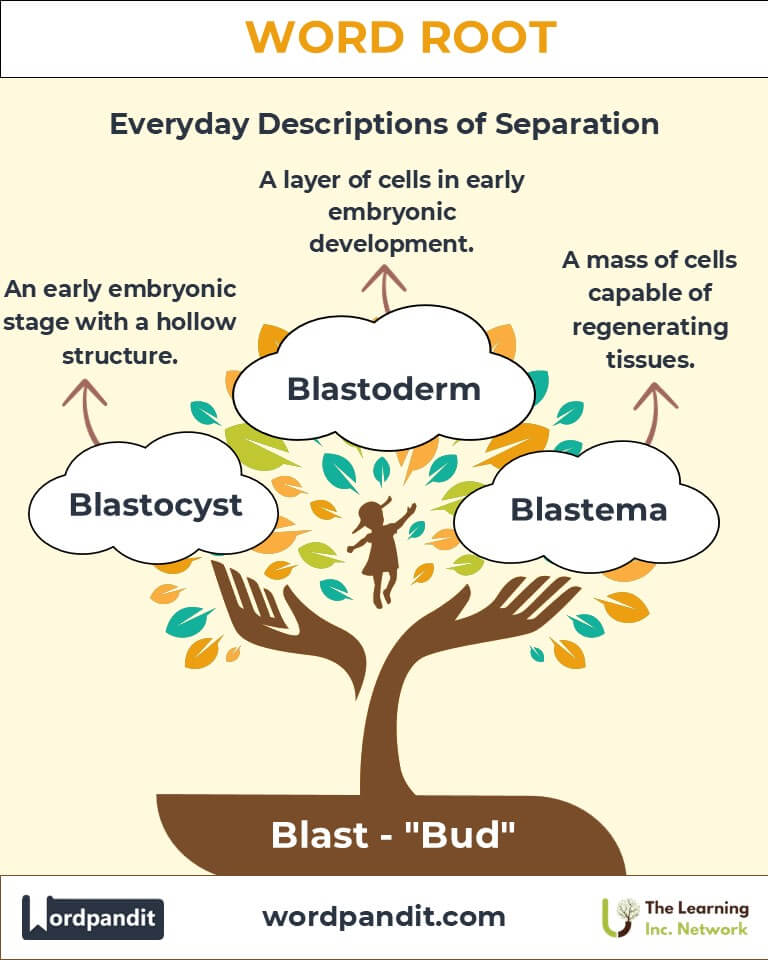Blast: The Root of Growth and Development
Byline: Discover the transformative power of the word root "Blast," derived from the Greek blastos, meaning "bud" or "sprout." Essential in biology and medicine, this root symbolizes growth, development, and the formation of life, reflected in terms like "blastocyst" and "fibroblast."

Table of Contents
- Introduction: The Significance of Blast
- Etymology and Historical Journey
- Mnemonic: Unlocking the Power of Blast
- Common Blast-Related Terms
- Blast Through Time
- Blast in Specialized Fields
- Illustrative Story: Blast in Action
- Cultural Significance of the Blast Root
- The Blast Family Tree
- FAQs About the Blast Word Root
- Test Your Knowledge: Blast Mastery Quiz
- Conclusion: The Enduring Legacy of Blast
1. Introduction: The Significance of Blast
What do embryos, regenerating tissues, and sprouting plants have in common? They all embody the essence of the root "Blast," which captures the earliest stages of growth and life. From the blastocyst in embryology to fibroblasts in healing wounds, the root underscores the dynamic processes of growth and development.

2. Etymology and Historical Journey
"Blast" originates from the Greek blastos, meaning "bud" or "sprout." Initially describing plant growth, its usage expanded with the advancement of biological sciences to encompass early developmental stages in animals and humans. Today, it remains integral to understanding life’s formative processes.
3. Mnemonic: Unlocking the Power of Blast
Picture a seed sprouting into a vibrant plant, each stage bursting with potential.
Mnemonic: “Blast—where life begins to bud and grow.”
4. Common Blast-Related Terms
- Blastocyst: An early embryonic stage with a hollow structure.
Example: “A blastocyst implants itself into the uterine wall during early pregnancy.” - Fibroblast: A cell involved in tissue repair by producing collagen.
Example: “Fibroblasts play a vital role in healing wounds.” - Blastoderm: A cell layer in early embryonic development.
Example: “The blastoderm differentiates into various germ layers.” - Hematoblast: A progenitor blood cell.
Example: “Hematoblasts are precursors to mature blood cells.” - Neuroblastoma: A cancer originating from immature nerve cells.
Example: “Neuroblastoma primarily affects young children.”
5. Blast Through Time
- Blastema: Historically used to describe cells capable of regenerating tissues.
- Blastokinesis: A term from embryology describing movements of early embryos within the yolk.
- Neuroblast: Once a general term for immature nerve cells, it now specifically refers to developmental neuroscience contexts.
6. Blast in Specialized Fields
- Medicine: Study of blastomas in oncology.
- Embryology: Exploring layers like the blastoderm.
- Regenerative Medicine: Researching fibroblasts for wound healing.
7. Illustrative Story: Blast in Action
Dr. Aisha, a regenerative biologist, discovered how to enhance fibroblast activity using growth factors. Her breakthrough healed chronic wounds, showcasing the profound role of "Blast" in advancing medical science.
8. Cultural Significance of the Blast Root
The concept of budding and growth resonates across cultures. From agricultural traditions celebrating germination to modern regenerative medicine, the Blast root symbolizes renewal and life’s potential.

9. The Blast Family Tree
- Cyto- (cell): Cytology, cytoplasm.
- Gen- (origin): Genetics, genesis.
- Morph- (form): Morphology, morphogenesis.

FAQs About the Blast Word Root
Q: What does "Blast" mean, and where does it originate?
A: The root "Blast" comes from the Greek word blastos, meaning "bud" or "sprout." It signifies the early stages of development and growth, particularly in biological and cellular contexts. This root reflects processes like budding plants, regenerating tissues, and embryonic formation.
Q: What is a blastocyst, and why is it important?
A: A blastocyst is an early-stage embryo, characterized by a hollow structure filled with fluid and surrounded by a layer of cells. It plays a critical role in embryonic development, as it is the stage where implantation into the uterine wall occurs, enabling further growth and differentiation into specialized tissues and organs.
Q: How do fibroblasts contribute to wound healing?
A: Fibroblasts are specialized cells that produce collagen and extracellular matrix proteins, forming the structural framework for tissue repair. They migrate to the wound site, facilitating healing by promoting cell proliferation and tissue regeneration.
Q: What is neuroblastoma, and who does it primarily affect?
A: Neuroblastoma is a type of cancer originating from immature nerve cells, often found in the adrenal glands or sympathetic nervous system. It primarily affects children under five years of age. Early detection and treatment are crucial for improving survival rates.
Q: What is a blastoderm, and what role does it play in development?
A: A blastoderm is a layer of cells that forms on the yolk surface in avian or reptilian embryos. It eventually gives rise to the primary germ layers, which differentiate into various tissues and organs. Its role is central to the early stages of embryonic development.
Q: How is the concept of "Blast" used in regenerative medicine?
A: In regenerative medicine, "Blast" describes progenitor cells, such as fibroblasts, that are capable of repairing or replacing damaged tissues. Techniques often involve stimulating these cells with growth factors to enhance wound healing and tissue regeneration.
Q: What is a hematoblast, and how is it connected to blood formation?
A: A hematoblast is a progenitor blood cell from which all blood cell types originate. These cells are fundamental in the process of hematopoiesis, which ensures the continuous supply of red blood cells, white blood cells, and platelets.
Q: How does the historical term "Blastema" relate to modern biology?
A: A blastema historically referred to a mass of undifferentiated cells capable of regenerating tissues or organs. While the term is less commonly used today, the concept remains central to studies of regeneration, particularly in species with high regenerative capacities, like salamanders.











